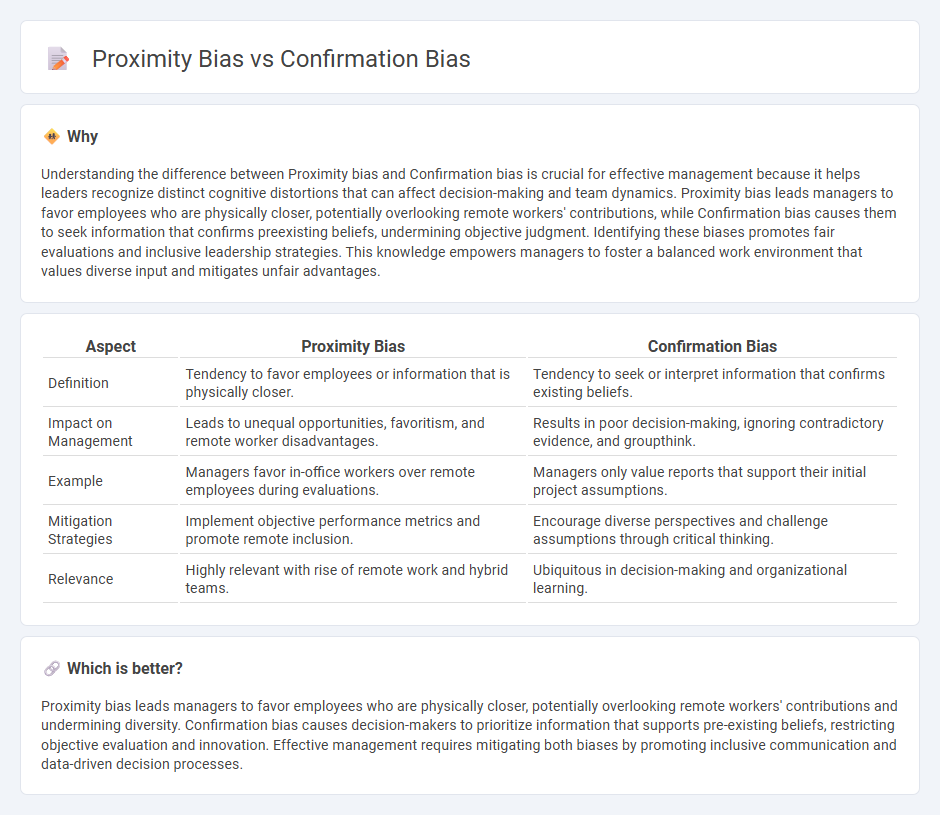
Proximity bias influences management decisions by overvaluing input from individuals who are physically closer, potentially overlooking remote employees' contributions. Confirmation bias leads managers to favor information that confirms their existing beliefs, hindering objective evaluation of diverse perspectives. Explore how acknowledging these biases can enhance balanced decision-making and team performance.
Why it is important
Understanding the difference between Proximity bias and Confirmation bias is crucial for effective management because it helps leaders recognize distinct cognitive distortions that can affect decision-making and team dynamics. Proximity bias leads managers to favor employees who are physically closer, potentially overlooking remote workers' contributions, while Confirmation bias causes them to seek information that confirms preexisting beliefs, undermining objective judgment. Identifying these biases promotes fair evaluations and inclusive leadership strategies. This knowledge empowers managers to foster a balanced work environment that values diverse input and mitigates unfair advantages.
Comparison Table
| Aspect | Proximity Bias | Confirmation Bias |
|---|---|---|
| Definition | Tendency to favor employees or information that is physically closer. | Tendency to seek or interpret information that confirms existing beliefs. |
| Impact on Management | Leads to unequal opportunities, favoritism, and remote worker disadvantages. | Results in poor decision-making, ignoring contradictory evidence, and groupthink. |
| Example | Managers favor in-office workers over remote employees during evaluations. | Managers only value reports that support their initial project assumptions. |
| Mitigation Strategies | Implement objective performance metrics and promote remote inclusion. | Encourage diverse perspectives and challenge assumptions through critical thinking. |
| Relevance | Highly relevant with rise of remote work and hybrid teams. | Ubiquitous in decision-making and organizational learning. |
Which is better?
Proximity bias leads managers to favor employees who are physically closer, potentially overlooking remote workers' contributions and undermining diversity. Confirmation bias causes decision-makers to prioritize information that supports pre-existing beliefs, restricting objective evaluation and innovation. Effective management requires mitigating both biases by promoting inclusive communication and data-driven decision processes.
Connection
Proximity bias and confirmation bias intersect in management by influencing decision-making through limited information exposure and selective validation. Proximity bias causes managers to favor employees or ideas physically closer or more visible, while confirmation bias leads them to reinforce pre-existing beliefs by interpreting information that confirms their views. Together, these biases narrow perspective and hinder objective evaluation, impacting team dynamics and organizational effectiveness.
Key Terms
Decision-making
Confirmation bias skews decision-making by leading individuals to favor information that aligns with their existing beliefs, while proximity bias prioritizes the opinions and inputs of those physically or emotionally closer, potentially overlooking diverse perspectives. Both biases limit objective evaluation, impacting the quality and inclusiveness of final decisions. Explore strategies to mitigate these biases and enhance unbiased decision-making processes.
Perception
Confirmation bias distorts perception by causing individuals to favor information that aligns with their existing beliefs, reinforcing preconceived notions and ignoring contradictory evidence. Proximity bias affects perception by making people give undue importance to individuals or information physically closer to them, often leading to skewed judgments and favoritism. Explore how these biases uniquely shape decision-making and interpersonal dynamics to improve awareness and critical thinking skills.
Workplace location
Confirmation bias leads employees to favor information that supports their existing beliefs about workplace location suitability, often overlooking contradictory data. Proximity bias causes managers to prefer and promote employees who work physically closer, impacting remote workers' visibility and career growth. Explore the differences and effects of these biases on workplace dynamics to improve organizational fairness.
Source and External Links
Confirmation bias | Definition, Examples, Psychology, & Facts - Confirmation bias is the tendency to search for, interpret, and recall information in a way that confirms one's pre-existing beliefs, often ignoring contradictory evidence, leading people to favor information that supports their views.
Confirmation Bias - Confirmation bias leads people to focus on evidence supporting their beliefs while dismissing opposing information, which can result in errors such as misidentifying causes or overlooking important factors in decision-making.
Confirmation bias - This bias involves not only searching for supporting evidence but also biased interpretation and recall of information, meaning even with the same data, individuals may interpret results to defend their prior beliefs.
 dowidth.com
dowidth.com